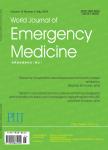Emergency department patient experience:Same location,same provider,different scores by different survey methods
Emergency department patient experience:Same location,same provider,different scores by different survey methods作者机构:Department of Emergency Medicine University of California Orange CA USA Institute for Clinical and Translational Sciences University of California Irvine CA USA
出 版 物:《World Journal of Emergency Medicine》 (世界急诊医学杂志(英文))
年 卷 期:2019年第10卷第3期
页 面:138-144页
核心收录:
基 金:supported by the Undergraduate Research Opportunities Program Faculty Advisory Board at the University of California,Irvine partially by the National Center for Advancing Translational Sciences,National Institutes of Health(NIH),through the Biostatistics,Epidemiology and Research Design Unit [grant number:UL1 TR001414]
主 题:Patient experience Emergency department Patient satisfaction Press Ganey Survey methodology
摘 要:BACKGROUND: Recent findings on emergency department (ED) patient experience surveys and concerns for the low response rates challenge the quality and reliability of the survey reports. We assessed the consistency of an ED patient experience survey report and identifi ed the effects of patient demographics on ED patient experiences. METHODS: We conducted a prospective, cross-sectional study at a university-based ED from July to December 2017. We obtained ED patient experience scores from an institutional version (IS) survey and the Press Ganey Associates-distributed survey (PGA). We compared top box scores from the two reports using frequency analysis and performed multivariable logistic regressions to identify associations between IS patient demographics and scores. RESULTS: We obtained 289 PGA and 234 IS responses. The IS reported signifi cant, higher top box scores in doctor-specifi c patient questions compared to PGA (all four P-values 0.01). Female, Christian and White patients were more likely to give top box scores (OR 3.07, OR 2.22 and OR 2.41, P-value 0.05, respectively). CONCLUSION: We found significant differences in ED patient experience scores between the IS and PGA surveys. We recommend that healthcare providers consider patient demographic variables when interpreting ED experience score reports. Multiple survey techniques and distribution methods may be adopted to best capture ED patient experiences.



